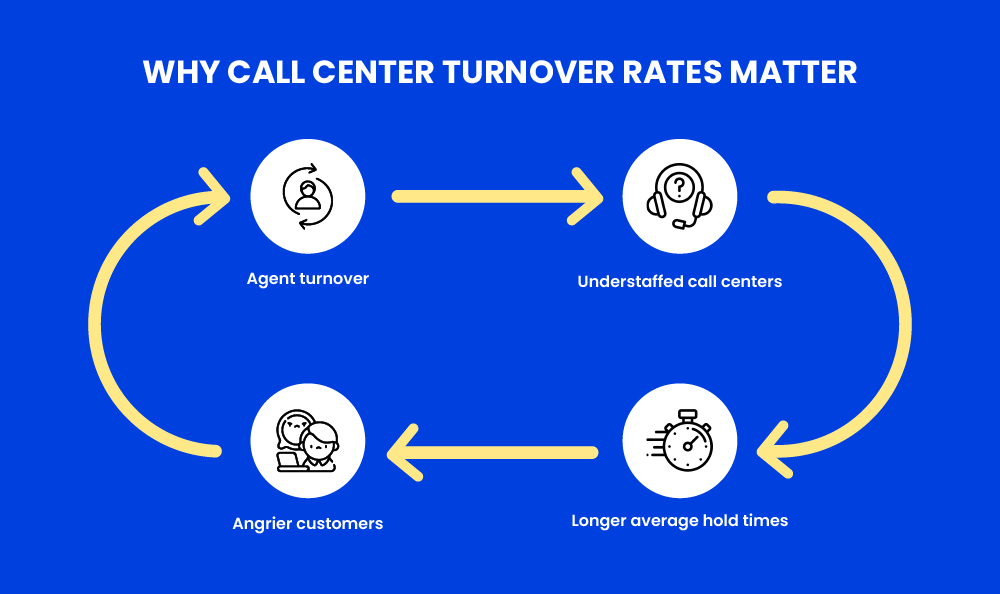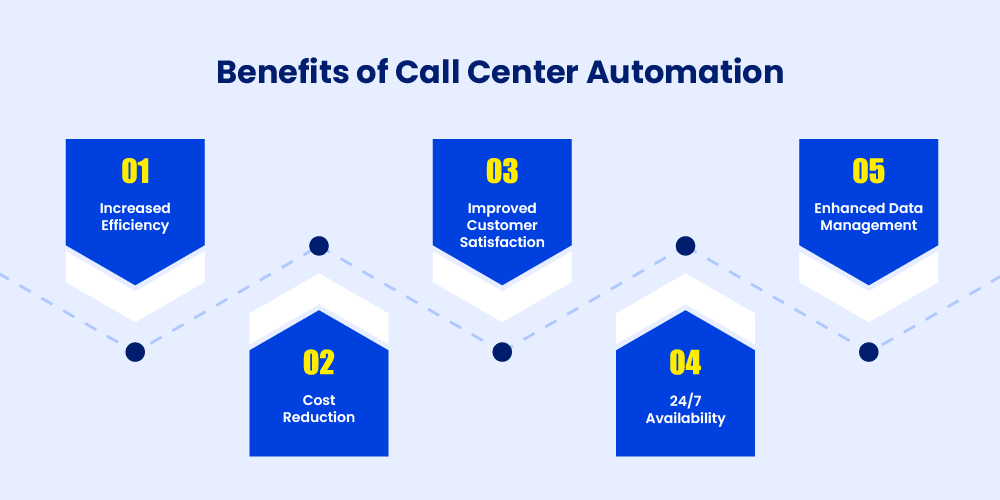Being the main point of connection for customers, contact centers are essential to maintaining their loyalty and happiness. To maintain high performance and service quality, managing contact center operations means supervising a large number of activities and difficulties.
This article covers the complexities of contact center operations, along with solutions to common problems and successful process automation and streamlining. Let’s dive in!
Understanding Contact Center Operations
Reaching corporate objectives and ensuring a smooth customer experience depends on the efficient administration of daily activities.
The major elements of contact center operations management consist of the following aspects:
- Workforce Management: Workforce management is making sure there are enough agents with the necessary abilities on hand when they are needed.
- Technology Management: It is the application of the proper instruments and technologies to facilitate activities and improve productivity.
- Quality Assurance: QA involves monitoring and improving the quality of interactions to ensure client satisfaction.
- KPIs: Key Performance Indicators are tracked to gauge performance and point up areas that need work.
- CRM: CRM (Customer Relationship Management) is the administration of interactions and data with customers to deliver effective and individualized service.
Daily Obstacles in Contact Center Management

Studies show that contact centers experience an average of 30% annual agent turnover, highlighting the significant challenge of maintaining a motivated and well-trained workforce.
To sustain efficient operations and outstanding customer satisfaction, managers of contact centers must deal with a multitude of everyday issues.
Among the difficulties are:
1. Very high call volumes
One of the hardest things is handling a lot of calls, particularly during busy periods. Exact labor management is necessary to guarantee enough coverage and reduce wait times. Unexpected problems can cause erratic spikes in call volume. It takes good planning and forecasting to manage these swings without sacrificing the standard of the service.
2. Attrition and training
Maintaining service quality requires that agents be motivated and well-trained. Operational disruptions and low morale can all result from high turnover. Therefore, it is possible to lower attrition and keep qualified agents by providing a supportive work environment and career development opportunities.
3. Application of technology
Technology is developing so quickly that it might be difficult to incorporate new tools and systems into current contact center operations. Efficiency can suffer from problems with data migration, compatibility, and the learning curve of new technologies. We must properly plan technology upgrades and provide sufficient training to ensure seamless transitions.
4. Quality control
Consistently providing excellent interactions across all mediums is difficult. It takes ongoing observation and input to guarantee agents provide the expected level of service.
Aspects of quality assurance include monitoring protocol compliance, customer happiness, and agent performance. Strong quality assurance procedures enable us to maintain high service standards, identify training gaps, and award outstanding workers.
5. Customer expectations
Contact centers have to change to keep up with the always-changing expectations of their customers.
Keeping competitive requires offering efficient and individualized service. Consumers want seamless experiences across channels, individualized interactions, and prompt resolutions. To meet these goals, it takes ongoing processes, technology, and training adaptation and improvement.
Also Read: Your Ultimate Guide to Customer Experience Management
Strategies for Streamlining and Automating Contact Center Operations

Organizations can use many approaches to automate and streamline procedures in order to manage contact center operations and overcome these issues successfully.
Some important tactics are as follows:
1. Application of advanced workforce management systems
Only effective workforce management ensures the right number of agents are available at the right times. Proactive workforce management systems optimize staffing numbers by using predictive analytics and historical data, therefore lowering the risk of both overstaffing and understaffing.
2. Using CRM systems
Effective management of client contacts and data necessitates a robust CRM system equipped with comprehensive features for lead management, automated follow-ups, and customer interaction monitoring.
Research indicates that nearly 82% of organizations utilize CRM systems for sales reporting and process automation. This integration significantly enhances the efficiency of handling client interactions, empowering agents with access to complete customer histories to deliver personalized service.
3. Using omnichannel communication platforms
Contact centers today must manage interactions through several channels. Omnichannel communication solutions combine all customer contacts into one interface, guaranteeing constant service quality and enabling agents to move between channels with ease.
These platforms provide insightful information on consumer preferences and actions, enabling more focused and successful communication. Omnichannel platforms integrate voice, email, chat, and social media channels to offer a unified customer experience.
4. Streamlining daily tasks
Because automation handles repetitive and routine tasks, it can greatly improve contact center operations efficiency. Chatbots and automated Interactive Voice Response (IVR) systems help lighten agents’ workloads so they can concentrate on more difficult problems.
Because automation offers quick answers to often-asked questions, it also improves response times and raises customer satisfaction. Chatbots, for example, can answer basic questions, and IVR systems can route calls according to consumer demands, ensuring that agents handle important encounters.
5. Improvement of quality assurance procedures
Contact centers should implement strong quality assurance procedures to preserve high-quality interactions. This covers conducting training sessions, providing agents with comments, and routinely monitoring calls and other interactions.
By identifying opportunities for improvement, automated quality monitoring solutions can examine interactions for adherence to preset criteria.
The insights AI-powered analytics provide into agent performance and client mood make targeted coaching and development possible for contact centers.
6. Using AI analytics
AI analytics can greatly optimize contact center operations. It can analyze massive amounts of data, spot trends, and provide a better understanding of consumer preferences and behavior. Predictive analytics makes it easier to anticipate client needs and take early action to resolve potential problems.
AI-powered technologies can also help agents raise the standard and effectiveness of their services by providing real-time recommendations during conversations. AI can, for instance, examine previous exchanges to promote products, offer pertinent fixes, or identify possible problems before they become worse.
7. Promoting a happy workplace
To reduce attrition and keep agent motivation high, a positive work environment is required. This entails giving agents continuous opportunities for training and development, acknowledging and rewarding achievement, and making sure they have the resources and tools they need to do their tasks well.
Establishing a cooperative and encouraging culture can greatly improve general output and job satisfaction. A motivated and involved staff can be developed via regular feedback sessions, team-building exercises, and chances for professional growth.
Best Practices for Managing Contact Center Operations


Apart from the above-indicated techniques, the following best practices can improve the efficiency of contact center operations even more:
1. Ongoing training
Agents need ongoing training and development to stay current on the newest goods, services, and customer service methods.
Agents who attend regular training courses can improve their abilities, maintain their motivation, and provide excellent service. Training should cover a wide range of topics, including problem-solving strategies, communication abilities, and product knowledge. Besides, giving agents access to self-paced learning materials can enable them to improve their abilities at their own speed.
2. Feedback and performance management
High service standards require regular performance reviews and feedback sessions. Helpful feedback allows agents to identify their areas of strength and growth.
Performance management tools can be used to track agent efficacy against key indicators. Agents can stay motivated and focused by setting well-defined performance goals and receiving frequent feedback.
3. Customer input
Gathering consumer feedback is crucial for gaining insight into client needs and raising the standard of service. Frequent customer surveys and analyzing their comments might yield important information about areas that need work.
Putting adjustments into practice in response to client input shows that one is dedicated to ongoing development and raises customer happiness. Social media, direct client contacts, and post-interaction questionnaires are just a few of the ways that feedback can be gathered.
4. Collaboration and effective communication
Smooth operations of the contact center depend on team members’ effective communication and cooperation. Giving agents the means of instantaneous communication and cooperation can improve productivity and team spirit.
Agents who regularly attend team meetings, exchange knowledge, and use collaborative technologies will be better able to collaborate and remain knowledgeable. Promoting a collaborative culture and encouraging open communication can also speed problem resolution and raise performance levels generally.
5. Planning business continuity and disaster recovery
Operating without interruptions requires a strong disaster recovery and business continuity plan.
This covers getting ready for any setbacks, including system breakdowns, power outages, or natural calamities. A well-defined strategy should specify how to keep things running during interruptions, including backup systems, other routes of communication, and emergency response protocols. The contact center is guaranteed to be ready for any situation through routine testing and updating of the strategy.
6. Flexibility and scalability
Contact centers must be able to expand and change as fast as business needs do. Implementing scalable solutions and adaptable procedures can help handle variations in call volumes, client demands, and corporate needs.
The scalability offered by cloud-based contact center systems enables businesses to swiftly add or remove resources as required, effectively managing variations in demand. Thanks to flexible procedures, contact centers’ ability to adjust to new possibilities and problems ensures their long-term success.
Also Read: How to Master Contact Center Sales
Wrapping Up
The efficient administration of contact center operations is crucial for reaching organizational objectives and guaranteeing customer satisfaction. By tackling daily issues and implementing plans to automate and simplify procedures, organizations can increase productivity, cut expenses, and raise the standard of their services.
Using strong CRM systems, omnichannel communication platforms, cutting-edge workforce management solutions, and AI-powered technologies can greatly improve contact center operations.
Any company wishing to improve its customer service operations will find LeadSquared’s CRM system a priceless resource. It offers a complete suite of tools to improve contact center performance.
FAQs
Effective contact center operations management includes workforce management to ensure the right number of skilled agents, technology management to enhance productivity, and quality assurance to monitor interaction quality.
Contact centers can manage high call volumes effectively by implementing advanced workforce management systems to optimize staffing using predictive analytics and historical data. Additionally, using automation tools like chatbots and IVR systems can handle routine inquiries, allowing agents to focus on more complex issues.
Ongoing training is crucial for contact center agents, as it helps them stay current with the latest products, services, and customer service techniques. Regular training sessions improve agents’ skills, maintain their motivation, and ensure they provide excellent service, ultimately enhancing overall customer satisfaction.









